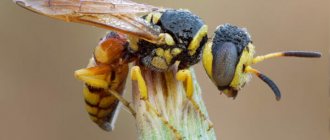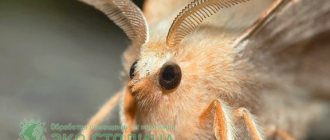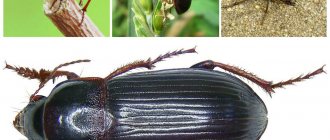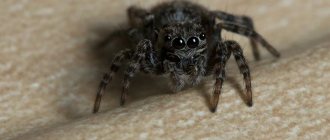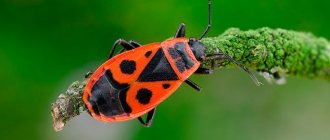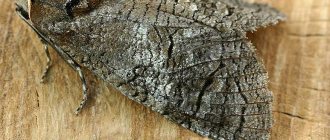Silverfish are insects from the bristletail order. Their genus includes only three species:
- Lepisma baetica
- Lepisma chlorosoma
- Lepisma saccharina
Lepisma saccharina, also known as the common, sugar, silverfish or simply silverfish, is the only species that is found in Russia; the other two live in the tropics. In nature, silverfish are busy processing organic matter, which they feed on, but sometimes they penetrate into rooms and remain there for a long time. What do they need in your home? Why and where do these insects come from? How to distinguish them from other similar pests and how to get rid of silverfish in an apartment?
Sugar silverfish: description
If you think that you have a sugarfish in your apartment, a description of its appearance and habits along with a photo will help you be sure whether it is it.
What does it look like
- Lepisma saccharinum has a round, flattened, elongated body, gradually tapering from head to tail.
- The body length of an adult individual usually reaches 1 centimeter; in particularly favorable conditions, insects can be slightly larger.
- The body is covered with chitinous plates that overlap one another like armor.
- The color of silverfish, depending on the stage of development, can vary from white to dark gray with a metallic tint. The older the silverfish, the darker it is.
- The head is crowned with two long mustaches, often equal in length to the size of the body.
- In the caudal part there are soft cerci directed to the sides and a long caudal filament in the center.
- The insect has three pairs of legs.
How it moves
- Moves in jerks, alternating running with short stops.
- Due to the position of the legs, during movement the insect’s body bends and wags like a fish’s tail.
- Due to its physiological characteristics, silverfish can only run on horizontal and inclined surfaces; they are not capable of reliably clinging to a wall or ceiling with their paws.
- The silverfish quickly runs away if the light is suddenly turned on in the room where it is located.
How it lives and reproduces
- Silverfish larvae look exactly the same as adults, but are smaller in size - on average 0.5 millimeters or more, depending on the stage of development.
- The larvae are always lighter than adults; they can be white, pearl-colored, or silver.
- Over the course of her entire life, each female silverfish lays about 100 eggs.
- At temperatures around 22° C, the larvae hatch from the eggs after about 40 days, at temperatures close to 32° C - after 20 days.
- The sugar silverfish larva develops to adulthood in approximately 1 year.
- If the silverfish does not die for reasons beyond its control, it can live up to 8 years.
- At temperatures of +5° C and below, Lepisma saccharinum can go into suspended animation and survive in this state without food for 9–12 months.
- Silverfish can molt up to 60–70 times in their lifetime, including as adults up to the age of 4 years.
Silverfish are sometimes confused with woodlice and two-tailed fish. Woodlice are rounder and have 7 pairs of legs, not 3, double-tailed ones are darker and larger, their cerci in the tail are harder, the insect can use them as a weapon, lifting them up and spreading them to the sides. Silverfish are not aggressive and always prefer to hide from any threat, exposure to sunlight and electric light.
What kind of insect is this?
Habitat
Silverfish are never seen in broad daylight. They can sit under window sills or baseboards. Insects settle in places where it is damp, dark and there is food: rags, books, cereals, construction waste. They usually choose pantries, cellars, bathrooms, kitchens, and libraries as their habitat. In the house, insects can be found in wallpaper, newspapers, and books.
Sugar silverfish appear in the apartment at the first opportunity. She is capable of covering impressive distances and remaining without food for a long time. The insect gets into the house with food or through cracks.
Types and external description of the pest
Silverfish are representatives of a genus of primitive insects. Wingless creatures need a moist habitat. They are distinguished by amazing vitality. They can live up to 300 days without food. There are about 190 varieties of them in the world. 10 of them are found in our latitudes.
Silverfish are easily recognizable. They have long antennae in front, and three tail filaments in the back. The size of insects does not exceed two centimeters. The body is covered with silvery scales, which is why the creatures got their name. The dense coating protects the body from drying out. The protection is weakened during periods of molting, of which there are up to 50 per year. Long antennae on the insect's head serve for orientation in space.
The creatures' food system is designed in such a way that it can digest cellulose. If the silverfish does not find more attractive food, it moves on to eating paper.
Parasites eat wallpaper, glue, books, synthetic and natural things, food waste and mold.
They are very hardy. The creatures do not bite people or pets, but they have an unattractive appearance, which forces owners to fight them.
Interesting! Scientists consider silverfish to be one of the oldest insects on earth that have survived to this day. The appearance of these creatures dates back to the Paleozoic era.
There are different types of insects found in nature. The most common are: comb, ant and common (aka sugar) silverfish. The latter prefer to live in our apartments. Pests are highly prolific. If silverfish are not removed from the apartment in time, their population will grow exponentially. The fight against insects should begin immediately after they are discovered.
Regular or sugar
Fear of light is a distinctive feature of the common silverfish. She prefers dark and damp places. Insects live in bathrooms, basements, closets and bookcases. The pest is a threat to library collections.
The color of the insect depends on its habitat. The scales of the parasite can be colored white, yellow, gray, or light green. Their appearance in the house is indicated by excrement that resembles ground black pepper. Waste products are little noticeable. They can be found on the table or inside the kitchen furniture.
Pests lay eggs in sugar, cereals, and flour. The products do not change taste or color.
The very name of the insect species suggests that the parasite loves sugar. But it is impossible to call creatures picky eaters. In the absence of food, they turn to clothes, paper and wallpaper.
Life cycle and reproduction
One silverfish cannot harm your home. But a family of ten individuals already poses a serious danger. Insects give rise to extensive offspring, which spread throughout the rooms.
In their development, creatures go through the following stages:
- Silverfish lay eggs. One clutch consists of 70 eggs, which are painted white. During development, they gradually darken, acquiring a brown color. At the optimal temperature (+30 degrees), the eggs develop quickly. The larvae emerge from them after 25 days. At lower temperatures it will take 40 days.
- Young larvae that emerge from eggs are not covered with scales. They appear much later. During their development, the larvae change their integument up to 5 times.
- The creature becomes an adult only after 5 molts.
The entire development cycle at a temperature of +20 degrees takes up to two months. This period is reduced at higher temperatures. The danger of insects is that they can live for a long time without food. At low temperatures they do not die, but fall into a cold stupor.
Causes of silverfish in the apartment
Silverfish can get into an apartment:
- Do it yourself, using ventilation shafts, grooves and cracks in communication wiring, cracks around windows and thresholds.
- Accidentally end up in packaging, bags or purchased goods.
- Cling to clothes, shoes, or get into your bag if you are in the place where they live for a long time.
- Arrive on pet fur after a walk or trip to the country.
- Live on houseplants and get into the house with a new potted flower.
If silverfish crawl on their own, then, as a rule, they live either in the nearest basement, or with neighbors, or on the street. In nature, Lepisma saccharinum lives under fallen leaves, stones, and in cracks in stone and cement masonry. In search of food in the summer, insects may well crawl into rooms, especially on the first few floors of a building.
The reasons for the occurrence of silverfish in an apartment cannot always be determined for certain, but this is not critically necessary information for pest control. What is much more important is why insects remain once they get into the apartment. For a comfortable life, they need a special environment and combination of conditions. For silverfish it is:
- Warm, optimally in the range of 22–27° C.
- High humidity – from 75% and above.
- Darkness.
- Secluded places, areas, crevices where you can hide.
- Water and suitable food.
The diet of silverfish includes foods rich in carbohydrates, in particular polysaccharides. In residential areas, silverfish can eat:
- Millet, oats, rye, barley
- Lentils, mung beans, peas, chickpeas
- Hair, exfoliated skin particles, dandruff
- Sugar and products containing it
- Paper, photographs, plaster
- Fibers of fabrics, clothing, interior items
- Remains of dead insects
- Chitinous coverings shed during molting
- Microorganisms growing in moist environments
- Decaying green houseplants
In search of food, silverfish are able to travel distances that are quite large for their body size, although they still try to somehow optimize their movements and, if possible, reduce their distance. Most often, silverfish can be found in an apartment in the bathroom, shower, toilet or kitchen. They can also be in rooms, but somewhere nearby there must be a dark, warm and secluded place with a high level of humidity. A crack next to a leaking battery or a flower pot with constantly waterlogged soil on the windowsill would be perfect for its role.
Who are silverfish and why do they appear in our homes?
Sometimes the first meeting with a silverfish can cause sincere surprise, since it is almost impossible to take these small and nimble insects by surprise during daylight hours. An elegant elongated body, shaped like a droplet or a small flat fish, slightly thickened in front, with tiny antennae and many legs, these are the distinctive features of this nocturnal creature, which prefers to live in bathrooms, kitchens, basements and toilets.
silverfish are a frequent visitor to apartments and houses with high humidity levels
Typically, these insects prefer to run exclusively on the floor, which is due to an attempt to get food. The main source of food for them is paper, fabrics, mold and mildew, which are typical for rooms with high levels of humidity, as well as starch, food debris, sweets, and glue, which is why they can cause significant damage to your home. A large number of multiplying silverfish can cause significant damage to your library, as well as archives with family photographs. They can also ruin your wardrobe and wallpaper, leaving small holes on them that resemble perforations.
silverfish can cause significant damage to your home library
In most cases, silverfish willingly move into rooms with obvious microclimate disturbances. The optimal conditions for them are a humid environment (from 75%), as well as the presence of heat (from 23 C) and a sufficient amount of food. These small creatures most often make their way into apartments through ventilation pipes, open windows, and cracks in the walls. However, sometimes you can accidentally bring silverfish into your home on your own, along with paper products, packaging materials, things from the basement, library books, and building materials.
The favorite habitats of silverfish in houses are:
- Bathroom, toilet and laundry room,
- Home library,
- Kitchen,
- Pantry,
- Basement.
You can notice the appearance of these uninvited guests in your apartment by traces of damage to property, as well as by accidentally discovering their droppings, which may end up on the table, dishes, and also in bulk food products. Outwardly, it resembles grains of black pepper. This insect can lay its eggs anywhere, however, it is very difficult to notice them.
Danger to humans
There is no direct threat from silverfish to humans, since they do not bite and do not carry pathogens of various diseases. But silverfish can cause other damage if there are quite a lot of them.
When there are a lot of them, you can expect the following actions from silverfish:
- These insects are considered the main enemies of archives and libraries . Silverfish produce a special enzyme that converts paper into nutrients. These pests can ruin the remains of wallpaper, various books or documents, which leads to the loss of necessary information.
- Numerous insects . Some females are capable of laying up to 200 eggs, and after a couple of weeks the same number again. When young individuals grow up, they will be able to lay the same number of eggs as their parents. As a rule, when there is a concentration of various insects in a home, this leads to panic and discomfort. In this case, it is better to forget about normal living conditions.
- Lots of waste . One can only imagine how much waste entire colonies of silverfish leave behind. In addition, their feces can easily end up in food, which is completely undesirable, and who would want to eat such products.
- The omnivorous nature of these insects . Silverfish can eat anything. They will eat wallpaper, even if it has glue, not to mention products made from linen, cotton or viscose.
Therefore, it is unlikely that any of the owners will desire such a neighborhood. If pests are found, then you need to immediately begin to destroy them.
Are silverfish dangerous for humans?
Silverfish:
- Don't bite
- Don't drink blood
- Are not carriers of diseases
However, like any other insects, silverfish live in contaminated places - sewers, ventilation, soil and come into contact with decaying organic matter. Their bodies, shed chitinous coverings, and excrement may contain harmful bacteria that can cause a local allergic reaction on the skin upon contact and lead to gastrointestinal problems if you eat foods that the silverfish have eaten.
Whether silverfish are dangerous to humans, things and objects in the house largely depends on their numbers. The more insects, the more often they come into view and the more abundant the amount of dirt from them. In addition, a large number of pests require more food, and damage to fabrics, clothes and objects can become noticeable. In order not to bring the situation to a critical scale, you need to start destroying pests as soon as you notice them. The sooner you start doing this, the easier and faster you will be able to get rid of insects.
Favorite habitats in apartments and private houses
Damp places are a home for insects. If there is mold and mildew in the apartment, you can expect the appearance of parasites. Dark corners of rooms are typical locations for these pests. Silverfish and other insects in the apartment must be destroyed so that they do not breed in large quantities.
The favorite place where insects settle is the bathroom. After a shower, it is recommended to wipe the floor and tiles, ventilating the room. Dripping faucets and pipes are another source of moisture that needs to be eliminated. Silverfish live in ventilation shafts.
Another favorite place for insects is the kitchen, since there is always moisture and food there. Basements, laundry rooms and attics should be under close attention.
Silverfish: how to get rid of an apartment - effective ways
To get rid of silverfish completely and permanently, it is necessary to combine preventive measures with extermination measures. In general, your pest control plan should look like this:
- Determine where pests accumulate and live by observing them and inspecting areas with a suitable environment.
- Change the microclimate in the apartment so that it becomes unsuitable for pests - first of all, reduce the humidity level.
- Carry out massive baiting of silverfish using selected means and methods.
- Isolate the house as much as possible from the penetration of insects by eliminating minor damage in the apartment and cosmetic or major repairs.
The last step is relevant in the prevention and control of any type of pests, therefore, by using the recommendations from this category, you will protect your home not only from silverfish, but also from much more harmful and dangerous insects that can encroach on it. What exactly is silverfish afraid of, how to get rid of it in an apartment, and what effective methods exist for this?
Reasons and ways of penetration of silverfish
A prerequisite for the existence of insects is humidity. That's why creatures sneak into our apartments. There are many ways through which parasites enter a home.
Silverfish enter houses through ventilation shafts. Cracks, crevices and open windows are sources of danger. The small size of insects allows them to penetrate through holes in walls.
Objects and products contaminated with larvae or adults are no less dangerous. Silverfish can be found in books, boxes, and products. The modest size of insects does not allow them to be detected immediately, since they are nocturnal. You can only see them if you suddenly go into the kitchen or bathroom at night and turn on the light.
Insects choose those apartments and houses in which the microclimate is clearly disturbed. High levels of humidity, condensation, cracks and debris in the house are an ideal habitat for parasites. Silverfish prefer damp and warm rooms. It is not difficult for them to get into any house. If the conditions turn out to be comfortable, the pests will settle in a new place.
Regulation of humidity, heat and microclimate
Reducing humidity and adjusting temperature is necessary no matter what method of pest control you choose. A special device for measuring humidity levels will help you track accurate indicators - a hygrometer or thermohygrometer, which, along with humidity, also shows temperature. You can reduce humidity by:
- Air dryer installations
- heater
- Heated towel rail
- Frequent ventilation
The level of humidity in the bathroom is greatly influenced by the state of ventilation, so if there is excess condensation, it is necessary to clean it first.
Prevention
Prevention of the appearance of silverfish consists of maintaining cleanliness and order in the house:
- Wet items should not be stored in the bathroom. Dampness is unacceptable as it promotes the proliferation of parasites.
- Periodically, the bathroom is dried using radiators.
- The premises are regularly ventilated.
- The cracks and holes are sealed to prevent silverfish from laying eggs in them.
- The toilet, bathroom and kitchen are washed regularly with chemicals or chlorine.
- For cleaning, you can use a vacuum cleaner to get into remote nooks and crannies.
- Ventilation holes are regularly treated with insecticides.
- A ventilation system is being installed in the bathroom. Dry air is the key to safety.
- Bulk foods in the kitchen are stored in sealed containers or bags.
- Spices are placed in bookcases to help repel parasites.
Silverfish appear only in rooms with disturbed climatic conditions. To prevent their occurrence, it is enough to carry out regular cleaning, maintaining cleanliness. Any dirt and mold are a guarantee of the appearance of unpleasant parasites.
Folk, improvised, natural remedies
Cedar oil
Cedar oil repels but does not kill silverfish. You can soak cotton pads in oil and place them in places where you often see insects, or prepare a mixture of 500 milliliters of water and 10-15 drops of oil, which you then spray on surfaces.
Helpful advice
Silverfish do not like the smell of any coniferous plants, so to repel them, you can use bags of fresh spruce and pine needles, as well as sawdust for rodents and wood fillers for cat litter made from coniferous wood.
Place pine needles, sawdust or pellets in areas where you often see pests. Sawdust and granules need to be changed once a week; bags of pine needles can be left for a year. Cinnamon
The smell of cinnamon repels silverfish. A suitable source is cinnamon sticks, powder or oil, which is mixed with water in a spray bottle and applied to surfaces where silverfish run.
Citrus
Oranges, lemons and other citrus fruits help repel silverfish, especially when fresh when the smell is most intense. You can use both skins and pulp. Once a week, replace dried cuttings with fresh ones so that the intensity of the smell does not decrease. You can make a surface treatment spray from lemon juice and water.
Carefully!
Lemon juice can lighten fabrics and surfaces.
Before applying it to any material, test the solution on an inconspicuous area or, if in doubt, choose an alternative method. Cucumber skins
Cucumber peels affect silverfish in a similar way to citrus and are used in the same way.
Bay leaves
Dried bay leaves help repel pests. They are especially convenient to use in kitchen cabinets.
Carnation
When fighting silverfish, cloves as a spice are suitable. The inflorescences must be placed in places where insects are found in the apartment. Cloves can also be used in the form of oil, soaking cotton pads in it or preparing a spray with it, however, the smell of cloves is very concentrated. Before you apply it to anything in your home, make sure you like it. It will be difficult to remove it from surfaces and objects.
Why use silverfish repellents?
Repellents are essentially absolutely useless in the fight against most types of pests, but in the case of silverfish, it makes sense to use them.
With their help, you can scare away pests from products and objects that they can spoil. To do this, you need to lay out and apply all repellents close to the places and things that you want to protect from insects. For example, in cupboards with cereals, in a drawer with dirty things in the bathroom, in closets with clothes, etc. Salt
The integument of the silverfish's body is quite thin, so any contact with salt can cause harm to the insect, even death. You can sprinkle salt directly on insects, or in places where you often see them. Leave the salt for a week, then vacuum it up. Repeat the procedure several times, tracking changes.
Diatomite
Diatomaceous earth, diatomaceous earth or diatomaceous earth acts on insects in the same way as salt, but works faster and more intensely. Diatomaceous earth must be scattered in areas where silverfish live. When contacting it, pests will die from dehydration.
note
Diatomite works only in a dry state.
It is advisable to scatter the powder in places where there is no strong draft, otherwise it will scatter throughout the apartment. Boric acid
From boric acid powder and starch-containing products, you can make food baits for silverfish and place them in small portions on substrates in places where the insects live. Mix boric acid powder with food bait in a 1/1 ratio. Suitable attractants with a high starch content are:
- Corn grains
- Rice
- Beans
- Potato
- Bananas
Food and acid must be mixed until smooth before use.
Carefully!
Place food baits only where pets and small children cannot reach them, or choose alternative baiting methods.
Baits with boric acid, if they enter the gastrointestinal tract, are equally dangerous for people, animals, and insects. Household cleaning products
Any household cleaning products, especially those based on chlorine, can destroy the integument of silverfish. Use them regularly to clean the bathroom, bathroom fixtures, and tiles.
Ways to fight
In order to prevent cohabitation with such unpleasant neighbors, you need to take radical measures. The control strategy consists of setting traps, chemical and mechanical methods.
The latter includes frequent ventilation of damp rooms, and thorough cleaning with a powerful vacuum cleaner of those places where silverfish can settle.
You shouldn't leave food for them. This means that you need to store things and products in hermetically sealed containers - jars, bags, boxes, containers.
Physical methods
There are different ways to combat silverfish.
To prevent silverfish from living in the bathroom, it is necessary to reduce the humidity. You should carefully inspect the pipes to identify leaks and repair them.
All rooms where insects were previously identified should be thoroughly cleaned and treated with bleach. After the walls and floors have dried, they must be coated with a solution of copper sulfate. This will destroy the silverfish eggs. You should open the bathroom so that the air in it becomes drier. It is advisable to install a forced ventilation system.
All rugs, towels and other things that were in the bathroom must be washed and dried in the sun. It is recommended to throw away items that are very damp.
Cold treatment of the apartment
Silverfish do not like the cold. In winter, when it’s cold outside, ventilating the apartment, in particular the bathroom, helps a lot. Open all doors and windows for ventilation for several hours.
If the room temperature is less than 10 degrees, the insects will die. This measure is more suitable for a dacha and country house, but can also be used in an apartment.
Folk remedies
Red pepper and tobacco help to quickly remove silverfish. To prepare the composition you need to mix 5 tsp. soda, 1 tsp. tobacco and 1 tsp. ground red pepper. The mixture must be diluted with 1 liter of warm water. The resulting product is used to treat the walls and floor of the bathroom. After this, you need to rinse the surfaces with water and bleach and ventilate the room well.
You can fight these insects with boric acid. The product is sold in powder form. Up to 25 g of this substance dissolves in 1 liter of warm water. The resulting mixture is used to treat areas under the bathtub and sink. The room is ventilated after the procedure.
You can use salt to repel silverfish. It is scattered in paths under the baseboards in the bathroom and toilet.
In addition, it is recommended to regularly wash floors, walls, furniture and bathroom fixtures with water containing citrus and lavender essential oils. This helps repel silverfish.
With the help of alum
- To combat these little pests, measure out 500 ml of boiling water.
- Dissolve 100 g of alum in it.
- Pour the resulting solution into a spray bottle.
- Spray the mixture in areas where silverfish are most concentrated. This will eliminate a large number of these little intruders. If necessary, the procedure should be repeated several times.
Insecticides
Insecticides in the form of aerosols, sprays and concentrates are suitable for treating silverfish habitats, for example, such as:
- August Cucaracha Spray
- Concentrate Medilis-Super
- Aerosol Clean House from skin beetles
- Raid Max aerosol
- Combat SuperSpray
Using any glue-based insect traps on substrates is also effective. They will need to be changed periodically as they become dirty.
How to effectively get rid of silverfish?
Specialized and homemade traps
Traps are one of the most popular remedies for silverfish in the apartment. With their help, you can collect adult individuals, and then treat the room with chemicals. Traps should be used until all the parasites are caught.
They can be purchased in specialized places or built independently, for example, in the following ways:
- The simplest trap is made from a liter jar, wrapping it on the outside with electrical tape or tape. You should put something sweet or a slice of bread inside the container as bait. Parasites will not be able to escape from the jar along the slippery walls. A wet newspaper rolled into a roll will become a trap for silverfish overnight. In the morning, all that remains is to destroy the nursery. The procedure should be repeated until the parasites disappear completely. Baits with a sticky surface attract insects. By placing them in different corners of the apartment overnight, you can harvest them in the morning. Traps should be destroyed daily. Commercial traps designed to catch cockroaches and other pests work well against silverfish. Devices from any manufacturer are suitable. You can use sweets or bread as additional bait.
Chemicals and insecticides
You can fight silverfish in apartments with the help of Karbofos. The drug was released to combat garden pests. But it is also indispensable in the apartment. With its help you can get rid of many household parasites forever. The drug is characterized by its long duration of action, low cost and high efficiency.
The only drawback is the terrible smell. With prolonged use of its active substances, parasites develop immunity. Therefore, drugs need to be alternated. Karbofos is incredibly toxic. You need to treat the room with this product in the absence of the whole family. After 48 hours, the house is wet cleaned. The drug is convenient for controlling insects in toilets and bathrooms.
You can remove silverfish using the Raptor gel preparation, which is applied near the cracks. The mixture can be applied in portions onto pieces of cardboard, which should then be placed around the apartment. Sticky traps collect parasites.
SES help
If you want to get rid of silverfish completely in 1 day, the only way to do this is to order pest control from the SES. You can treat any separate room where insects live, for example, a bathroom or kitchen, or the entire apartment. When disinfesting an entire apartment, the service is provided with an official guarantee for a period of 1 to 3 years, depending on the method of treatment.
SES "Des Group" has been providing high-quality sanitary services under an official contract in all districts of Moscow and the Moscow region since 2014. The cost of treatment depends on the area of the room/apartment, the disinfestation method and the products used. You can clarify it by contacting the service consultants by phone, or by leaving a request for a call back from a specialist through the form on the website. The Dez Group manager will call you back within 5 minutes after receiving it.
Chemical destruction of silverfish
If you have already tried all the known methods of combating this scourge and your efforts have not led to getting rid of this parasite, then it is probably time to contact the professional pest control service “Sanitary Day” whose specialists will not leave your request unattended and will promptly arrive at Your facility for chemical disinfestation. To professionally destroy these bugs, strong drugs that are not widely available and, often, special equipment are used.
The most common chemical preparation for getting rid of silverfish is liquid cypermethrin, an aqueous emulsion of which is used to treat crevices and cracks around baseboards and doors. This method is effective for killing adults, but is not effective against laid eggs.
Safety precautions for chemical destruction of silverfish
- Insecticides used to control silverfish are potentially harmful to mammals.
- Use disposable face masks to protect your respiratory system when applying insecticides.
- Avoid using insecticides near food, food items, utensils, and food preparation surfaces.
- Keep children and pets away from these substances.
- Read and follow the instructions when handling silverfish insecticides very carefully.
It is worth noting that infestation of a bathtub or apartment by these insects occurs very quickly and is not noticeable. If measures are not taken in time to get rid of the silverfish, then these bugs can cause a sufficient number of problems, ranging from health problems to damage to repairs. In order to prevent your apartment from becoming infested and not to face the problem of getting rid of silverfish again, you need to change the conditions that make your apartment or its individual rooms (for example, a bathroom or kitchen) attractive to silverfish.
For prevention purposes, use natural control methods that repel them and are safe for humans and pets. Sometimes the fight against silverfish can drag on for a long time and not lead to the complete destruction of insects. If, despite all the efforts made, you cannot get rid of silverfish forever at home and all the efforts you make do not lead to the desired result, do not forget about our specialists who are always ready to help in the current situation to remove parasites from your apartment with a guarantee forever. By ordering the treatment of an apartment or bath, you will receive comprehensive measures to destroy and protect your home from silverfish, and our specialists will also give recommendations on improving the sanitary conditions of your apartment to prevent the reappearance of insects in the future.
Means and methods to get rid of silverfish
To combat the pest you need to use different means. When carrying out disinfection, the poisonous liquid must be alternated, since pests get used to its action.
It is preferable to use folk remedies when the number of pests is small, and chemical preparations are recommended to be used when there is a massive accumulation of insects.
With the help of alum
To prepare the solution you will need to boil 100 ml of water. Dissolve 100 g of alum in the resulting liquid. Stir the resulting mixture until smooth.
Pour the liquid into a spray bottle and use to disinfect the room. For complete destruction, treatment should be repeated at least 2-3 times.
Using boric acid
Preparation of the product:
- Combine boric acid with chalk in a ratio of 1:4.
- Mix the ingredients until smooth.
Sprinkle the resulting powder generously in all corners and in places where pests are concentrated. After a week, remove the mixture along with the remains of insects.
Then re-pour the powder into all corners of the room, not forgetting the most secluded places. This will help destroy the hatched larvae from the oviposition. After 7 days, completely collect the product and carry out general cleaning using chlorine-based cleaning liquids.
Baking soda, red pepper, tobacco
To prepare this solution you will need to take 3 g of each component. Pour the mixture into 1 liter of warm water. Stir the solution and leave to infuse for 30 minutes. After the time has passed, strain the liquid and pour it into the sprayer.
Spray an even layer of the solution into suspected pest habitats. Leave for 8 hours. Afterwards, do a wet cleaning and dry the room.
Spices
You can cope with a small accumulation of pests with the help of spices. An effective combination is a mixture of cinnamon and cloves.
The mixture should be sprinkled in all corners, in the bathtub, in cabinets and on shelves. This will help repel insects and force them to leave the room.
On a note! Bay leaves, sage and garlic have a similar effect.
Cedar shavings
The smell of fresh cedar wood has a depressing effect on the pest. By scattering shavings, you can force him to leave his home.
The wood should be changed regularly as it dries, so that the smell is constantly present in the apartment for 2 weeks.
Why do insects appear in the bathroom?
The main reason for the appearance of these creatures in the toilet and bathroom is high humidity. There is an increased risk of insects in apartments where major renovations have not been carried out for a long time, plumbing leaks and there are cracks in dark corners. However, these centipedes do not only start from dampness.
Both long and small centipedes love high air temperatures. Failure to comply with sanitation rules is often enough for bugs to appear. An overflowing trash can attracts silverfish. Favorable conditions for this living creature are created by poor ventilation in the house.
Silver and white silverfish
It is difficult to get a good look at a living silverfish, because... it moves quickly, but in the photo you can see the body structure of these creatures. Both white and silver silverfish are found in human homes. These varieties differ only in color. Some insects have a dark gray or black carapace, but have a shiny silver coating on top.
The structure of silverfish.
Other varieties of silverfish have a transparent white shell. It also has a silvery patina.
Adults look like tadpoles. The head is large and the tail is thin. There are long mustaches on the head. These creatures have 4 pairs of main legs and 8 pairs of auxiliary legs. Thanks to the special structure of their limbs, silverfish crawl quickly both along the floor and along the walls.
The favorite habitats of these insects are:
- far corners under the bathtub;
- places where condensation accumulates;
- hidden communications;
- jars of detergents;
- wet towels, mats and sponges.
These places have something in common - high humidity. Here, adult individuals live and also lay eggs, from which not too long white worms emerge. They look like thin caterpillars. They cannot run fast, so they are most often found in places where wet, caked clothes or towels have been left for a long time, as well as in the far corners of the bathroom, where cleaning is not done often.
Insects feed on organic matter . They consume mold, mucus, toilet paper, food scraps, natural fabrics, wallpaper paste, etc. Thus, these creatures can find enough food in the bathroom.
Recommendations for disinfection in the apartment
It is recommended to react to the appearance of uninvited guests immediately, without expecting mass spread. Both chemicals and folk remedies are suitable for killing insects in a room/apartment.
You need to start processing after following a number of recommendations:
- It is first recommended to do a wet cleaning of the apartment , thoroughly wash all secluded places using cleaning liquids with the addition of chlorine. Wait until the treated surfaces dry.
- Remove children and pets from the premises and cover the aquariums with film.
- Prepare special clothing , a respirator and rubber gloves for your own safety.
- Pack all products in airtight bags or seal them in jars.
- Move all objects away from their intended habitats, clear out the corners.
- Spray the poisonous agent in all corners and surfaces.
- Close the windows and doors of the room for 1 hour.
- After time has passed, ventilate.
- Do not carry out wet cleaning for 1 week, then disinfect again.
- After waiting a week after re-treatment , wash all surfaces again and place objects in their places.
If silverfish are infested in clothes and bookcases
Cabinet doors should be left open periodically to reduce humidity.
In this case, it is recommended to use homemade traps to help catch insects.
You can use any of the following options:
- Wrap the outside of the glass jar with electrical tape. Place bait in the form of sugar or starch at the bottom. Place the container in a closet, shelf or other place and leave overnight. The pest will smell it and will rise up and fall into the trap, and will not be able to get back out along the internal slippery wall.
- Roll up the newspaper into a loose roll. Place rubber bands on both sides to prevent the paper from unrolling. Lightly moisten it with water. Lay oilcloth on the cabinet shelf and place a folded roll of newspaper on top. Leave the trap overnight. In the morning, take the roll outside and burn it.
To prevent uninvited guests from re-occupying your closet, you should use repellent seasonings:
- cloves;
- sage;
- laurel leaves;
- cinnamon.
Cabinet doors should be left open periodically to reduce humidity . Clothes should always be dried and ironed. Books should also be shaken periodically and dust removed from them.
These simple recommendations will help you get rid of silverfish in your closet, chest of drawers and bookshelves.

